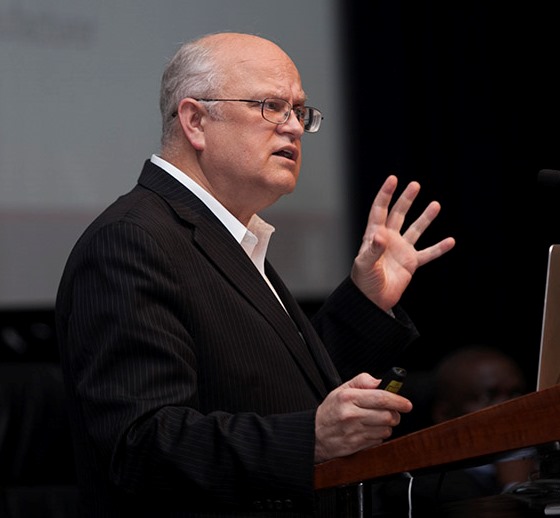In stark contrast to past years Thomas Sterling’s ISC20 keynote today struck a more somber note with the COVID-19 pandemic as the central character in Sterling’s annual review of worldwide trends in HPC. Better known for his engaging manner and occasional willingness to poke prickly egos, Sterling instead strode through the numbing statistics associated with the pandemic and then turned to optimistically spotlighting the worldwide HPC community’s rapid pivot to attack the pandemic.
Perhaps this was appropriate. The full-fledged ISC20 conference scheduled to happen in Frankfurt, Germany, has been transformed into a digital-only event with a slimmed down agenda delivered by livestreaming and prerecorded sessions. Sterling’s keynote – his 17th – was prerecorded. The pandemic has wreaked global damage on health, economies, and disrupted lifestyles.

“This was not easy for this year because this year is like no other year, certainly in my lifetime, and I suspect most of yours. I chose ‘a world in hope’ (as his theme for the talk) because wherever you are, I think we are experiencing the same sense of need for a future that is better than our present. Sadly, many have lost their lives since I last presented on this virtual stage. And there are more than one kind of worldwide dilemma, crisis, really. It is a health crisis. It is an economic crisis. And for those of us in the US, it is a crisis of conscience, long overdue,” said Sterling.
There was some core HPC technology discussion too. Sterling, professor of engineering and director, AI Computing Systems Laboratory, Indiana University, lauded the innovation and performance of Fugaku at the RIKEN Center for Computational Science (R-CCS) in Kobe, Japan, which finished atop the latest Top500 by a wide margin.
“This is the machine that I would claim was redesigned and pretty much from scratch now. Now that’s not 100% true, it does use an ARM CPU and a manycore [approach] for that matter. But this is on a chip and a framework that provide very high bandwidth and very low latency at least among the local parts, and a very high bandwidth and rapid switching network on the chip and scalability. In addition, it has a custom-made accelerator, a processor sort of GPU-like, the SVE, designed by Fujitsu, that is both speeding up integer and floating point at different speeds including its own cache and very tight packaging, as well as massive memory bandwidth in and out of the accelerator.
“This machine is not just for numeric computing. It is not just for graph computing. It is designed in particular to be able to advance the capabilities in artificial intelligence, including but not limited to machine learning. And one exceptional note is that because of the COVID-19 crisis, [Satoshi] Matsuoka at RIKEN and his colleagues expedited the deployment. Originally it was supposed to be deployed next year in 2021. But part of the machine, at least has been deployed now and is running science applications targeting the COVID virus.”
During his talk, Sterling also dug into the long-term structure of the Top500 and noted the passing of a few prominent members of the HPC community as well as recent award winners (more on both below) but he spent most of his time discussing the pandemic and HPC efforts to collaborate in the fight against it. It was a different sort of talk.
Here are two sobering slides and one hopeful one.
“You can observe the red curve that shows the monotonically increasing number of cases. The other bars are the additional cases added per day in the different geographical areas. Yellow is the European. Green is the Americas. And I believe that includes not just the US, UK, Canada, Mexico and South America and the gray covering the myriad other countries That either have or are now experiencing the same virus. And in that area, you can see that this represents the trend, the transmission of that disease to many other areas parts of the world,” said Sterling.
“This is more sobering, if anything, this is not the number of cases this is the number of confirmed deaths on a per daily basis and the black line is the world, the world the death rate, where we see that something on the order today of 3000 4000 people dying every day. I guess the good news here is that number was more like 8000 on a daily basis. And has somewhat subsided,” he said.
He commented on the fact that various regions have taken different approaches to controlling the pandemic, noting for example that Sweden is relying on development of “herd immunity” over time which implies taking less active measures. He left open the question of how effective that strategy would be. He’s encouraged by some efforts, in particular New York City, which is where he was born. See slide below.
Sterling, “This chart is from New York City and it is a number of deaths on a daily basis for New York. And, clearly the take home message is that New York suffered greatly at its peak, and through stringent measures, and I credit both the governor of New York Cuomo and the mayor of New York City de Blasio and they didn’t always get along with each other but by together applying control methods with the engagement of the populace, mostly, we see that the number of deaths per day diminished to not quite, but almost zero. This is this is wonderful. I can’t help but stare at it.
Veering away from the somber tone used to review pandemic statistics, Sterling perked up, enthusiastically pointing to the worldwide HPC community’s massive pivot to engage in pandemic-fighting research. The HPC world came together, “not purely by intent or organization, but by natural inclination internationally to address the challenges of this unique and painful crisis around the world. I just want to show you a few examples and my apologies ahead of time, if I don’t do adequate representation of all of the places are working to this,” according to Sterling.
It’s best to watch his presentation for the details. Here are just three of his slides singling out efforts representative of the HPC community.
In looking at the Top500 constituents over time, Sterling presented what may be familiar data to some contending the Top500 is comprised of three distinct communities – Three Worlds of Supercomputing – in which the top ten or so systems have always accounted for the bulk of the performance and where the number of system in each category has remained roughly the same.
“We recognized that, in fact, there isn’t a continuum of capabilities across those two orders of magnitude, which is roughly what it is between number 500 and number one, but rather, it’s highly polarized where as you can see on this chart, the Top500 rank is on the horizontal axis and the machines are ordered from right to left in the lowest performance up to the highest performance. And what you see here is that or at least we assert that there’s kind of a three worlds model. There’s what we call the mainstream, which sits at almost flat horizontal line that covers most of the graph. It’s leadership meet leadership machines, which is that essentially vertical line way at the left. Then there is this small number of additional machines that kind of fit between there.
“But the big take home from this is almost all of the computing that almost all of us get to do – it’s along that horizontal law line and is mainstream and while we put a lot of focus attention on that vertical line, it represents a very small percentage in numbers in counts within the top 500. It does consume a disproportionately large amount of the total aggregate performance. If we take that data and we look at it a little different, we see that the mainstream computing, the number of machines on the mainstream computing is almost flat. And this is just over the last decade. This doesn’t go all the way back.
“You also see that the leadership machines, the number is well within the top 10. And this has been continuously so the top 10 machines are where the leadership computers reside, and they certainly don’t reach out further than that. Then somewhat varying is, is the middle area that goes roughly between a factor of 10 and maybe something like 70 or 80 across the years. I also point out to you that on the right-hand side of this, for all three, the numbers are really flatlining, which is interesting,” said Sterling.
Further analysis, said Sterling, reveals “It takes about eight years for a machine that would be number one on the list to slowly migrate down to number 500. And you can do that exercise yourself. So the lifespan of a machine is about eight years. Many machines don’t survive that long because while they do provide that performance or other normalizing factors, not the least of which is operational cost and the value of floor space, which could hold a lot more performance, so we tend to roll them out faster than that.”
He singled out recent HPC award winners – Geoffrey C. Fox (Kennedy Award), Edwin Catmull and Pat Hanrahan (ACM Turning Award), David Kirk (Seymour Cray Award), and Chris Johnson (Sidney Fernbach Award). Sterling also paid tribute to a number of HPC community members. Among those who have recently passed away he singled out Rich Bruekner (InsideHPC), Anne Redelfs (UCSD), Steve Tuecke (ANL and Globus founder), and Lucy Nowell (DoE, NSF).
Sterling’s slides about the winners and the recent losses, with a few details about each, are presented at the end of this article.
Here’s a link to his full keynote: https://2020.isc-program.com/presentation/?id=int_spe102&sess=sess272
AWARD WINNERS
IN MEMORIAM









































































